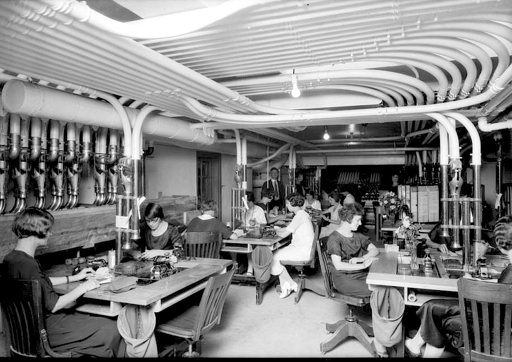I was reading A Coffin for Dimitrios (great book), and found a character saying “send me a pneumatique when you get to Paris.” And in fact, there was a series of pneumatic tubes to speed the mail in Paris for over 100 years. Thought it was cool. Here’s the wiki as well.



Some of those systems are still around. For example, Roosevelt Island in NYC has a pneumatic trash collection system. Apparently it’s the only part of NYC that doesn’t have trash piling up on the streets/sidewalks all the time.
New York almost had a pneumatic subway system, but the inventor tried to go around Boss Tweed. Big mistake.
https://en.wikipedia.org/wiki/Beach_Pneumatic_Transit
Pneumatic transit and atmospheric rail were kinda a fad in the 1800s. Even if it had been built it would have mainly been an attraction rather than a mode of transport. They were never really able to hammer out the kinks with maintenance and safety.
Funnily enough an atmospheric rail incident on the Dalkey atmospheric railway was more than likely the first time a human sustained a land speed over 100mph.
The son of the owner accidentally loosed the break on a single carriage that was supposed to convey a whole train and accidentally shot himself off alone, covering about 2 miles of track in less than 75 sec. Which in the 1840’s would have been like engaging a Victorian warp drive.
FWIW there is a modern atmospheric railway in use today:
https://en.wikipedia.org/wiki/Porto_Alegre_Metro#Airport_connection_people_mover
Oh yeah, the people mover is really cool. Always been a goal to actually ride it if I ever make it down to Brazil.
It’s a little bit easier to make them work nowadays with modern materials, rubber is probably a little more pleasant of a sealing material to work with compared to the og bearskin and lard.
Though one of the benefits of the lard is that the og one always smelled like a fry up when in use.
Bearskin and lard?
Back in the days before vulcanized rubber and plastics if you wanted to make a somewhat air tight seal you had to soak an animal skin in fat. With the amount of pressure you need to move a train, you need a pretty big and durable animal skin.
We have had those in parts of Sweden for a long time.
Apparently they were invented in Sweden in the 1960s
But most of Sweden doesn’t have those and we never have trash bags or something on the streets.